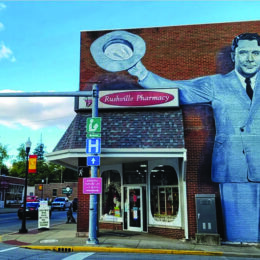

Knox County is a county of firsts. Established in 1790 along the eastern banks of the Wabash River, it was the first county in what became Indiana — 26 years before Indiana even became a state. Its county seat, Vincennes, was founded by the French in 1732 and is Indiana’s oldest city. When the U.S. Congress carved the Indiana Territory from the Northwest Territory in 1800, Vincennes was made the capital city.
It was in Vincennes that Indiana Territory Gov. William Henry Harrison founded Indiana’s first college — what became Vincennes University — in 1801. And also in Vincennes, printer Elihu Stout started the Indiana Gazette, Indiana’s first newspaper.
While Indiana may not immediately come to mind when talking about the American Revolutionary War, a key victory was won in Knox County. In late 1778, British forces from Detroit recaptured its outpost on the banks of the Wabash in Vincennes. Word of the British takeover soon reached George Rogers Clark, a lieutenant colonel from Virginia, who was garrisoned with his militia at an outpost south of St. Louis.
In early February 1779, Clark set out with about 170 men on the 160-mile trek eastward across the frigid and flooded plains of what today we call southern Illinois. Clark and his men — cold, wet and hungry — arrived at Vincennes on Feb. 23. The town’s French residents greeted Clark’s men, providing food and dry gunpowder. Clark’s men then surrounded the fort and the British surrendered in just two days without Clark losing a single soldier.
The surrender represented much more than just taking a little one-acre fort on the frontier. Clark’s victory here and continued disruption of the British throughout the rest of the war changed the dynamics of the western frontier.
At the 1783 peace negotiations in Paris, which officially ended the war, the British wanted the new north/south boundary between British and American holdings to be the Ohio River. However, with Clark’s conquest at Fort Sackville, north of the Ohio, the American negotiating team succeeded in moving the boundary to the Great Lakes. Thus the Northwest Territory was created as a part of the newly-formed United States. That territory now includes Ohio, Indiana, Illinois, Michigan, Wisconsin and eastern Minnesota.
The fort’s exact location in Vincennes is not known, but it is believed it was on the grounds of the present-day George Rogers Clark National Historical Park.
Sites to see:
• Red Skelton Museum of American Comedy, on the campus of Vincennes University, and literally across the street from where he was born in 1913.
• Grouseland, the home of William Henry Harrison and the territorial mansion when he served as governor of the Indiana Territory, 1800-1812.
• George Rogers Clark National Historical Park, dedicated along the banks of the Wabash River in 1936 by President Franklin D. Roosevelt.
• Indiana Military Museum.
• Brouillet House, a French 1790 log home.
• Sonotabac Prehistoric Indian Mound.
County Facts:
Founded: 1790
Named for: Major General Henry Knox, the first U.S. Secretary of War, 1789-1794
Population: 38,440 (2010)
County seat: Vincennes
Noted for: Being the oldest county in Indiana; site of a Revolutionary War battle memorialized at the George Rogers Clark National Historical Park on the banks of the Wabash River in Vincennes; Vincennes, the oldest city in Indiana and the original capital of the Indiana Territory; birthplace of the late beloved vaudeville, movie, radio and early TV comedy entertainer Red Skelton.



